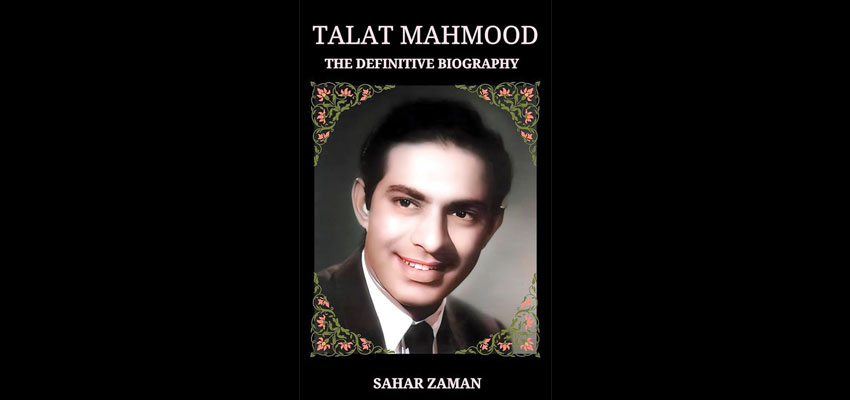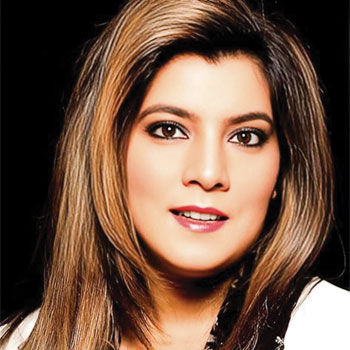King of Ghazals

"In the book, Talat Mahmood: The Definitive Biography, by Sahar Zaman, the grand-niece of the legendary singer, delves deep into the life of a man whose velvet voice is synonymous with the golden era of Hindi cinema and music. A versatile vocalist who effortlessly sang for artists as diverse as Dilip Kumar, Bharat Bhushan and Shammi Kapoor, lightly skipping between film music and ghazals. A singer who inspired the likes of Jagjit Singh and Pankaj Udhas. Beyond the God-given talent, the playback singer was also a true gentleman. His soft-spoken nature and impeccable style reflected his calm and composed personality-qualities admired by everyone who knew this Padma Bhushan winner. The book does him justice"
If an artist is defined by the era, he also defines the era
An apt description for Talat Mahmood: The Definitive Biography, penned by his grand-niece Sahar Zaman, a noted television news journalist and cultural curator. But, to simply term the work as a biography of the man with the velvet voice, whose work headlined the leading films and concerts of his age, is to do the scope and subject of the book, a disservice. As Zaman puts it, “This is not a standalone story; his life was placed in an era that shaped our country...it spans the golden era of Hindi film music, the evolution of music technology, and so much more.”
In short, Zaman’s work is not just a celebration of her Bambai Nana’s life and work, it pays tribute to an era gone by. It helps that the author has skillfully woven the assorted skeins into a beautiful, nuanced tapestry that affords aficionados and new-gen readers alike, a closer look at the man, his music and world.
So, what took her this long to write the book considering her relation to him? “I didn’t realise how much this book was awaited by music lovers and film fans,” she admits.
The idea took seed in 2015, with the first concerts dedicated to his memory performed in 2017. “Initially, it was simply about giving back to the man whose art inspired me. But, I realised his journey was multifaceted. There were many sides of him that didn’t fit into a concert format. They needed a book.”
Bit by bit, she timed the book to coincide with his centenary in 2024. “I was convinced in 2022 that it was time. I consciously chose to self-publish—it meant overseeing everything from layout to promotion. But, it also gave me full creative control.”
Was it hard to remain objective, given their familial connection? “As journalists, we’re trained to be true to the story,” she says. She cross-verified anecdotes, checked timelines, and interviewed many who knew him, and bit by bit the portrait emerged. “He lived transparently, made bold choices, and stood by them. Plus, he had the charm to carry difficult things off,” she smiles.
The narrative flows through three cities: Lucknow, where he was born and schooled; Kolkata (formerly Calcutta), where his Bengali songs as “Tapan Kumar” had the Bhadralok thinking he was native; and Bombay, where his playback career soared. Throughout, the narration remains lucid, evocative and layered.
Clearly, this isn’t a book to speed through. It’s one to be savoured slowly—all the better to soak in the memories, sift through rare photographs, and know more about a world that no longer exists.
The early years

One would have thought that a young man born into a cultured and privileged Muslim home that prioritised education and secularism, would have had it easy; particularly, since he was supported so much by his much-respected paternal aunt Mahlaqa Begum. But, Talat’s father was far from thrilled-a Gandhian to the core, he had other dreams for his son. Besides, young Talat was shy and timid. Believe it or not, the man whose global fan following would eventually include the likes of President Gamal Abdel Nasser Hussein of Egypt and King Mohammad Zahir Shah of Afghanistan, actually froze with stage fright, as he sang his first few lines before his schoolmates. “I can’t do it..it’s not in me!” he cried, but his kindly Bua helped him get past the first setback.
Gentle yet unwavering, when it came to things that mattered to him, Talat’s quiet rebellion defined him—whether during the “mike down” protest by playback singers for fair recognition or marrying a Bengali Christian woman, at a time when interfaith unions were taboo. He chose artistic integrity over commercial compromise, often rejecting songs he felt lacked lyrical quality.
Title: Talat Mahmood: The Definitive Biography
Available on: Amazon (Kindle)
Price: 450 (Kindle) and `750 (Paperback)
No. of Pages: 364 (Paperback)
Publisher: Notion Press
A man of many talents
Not only did Talat sing in films, but he also acted in them and enjoyed a parallel career in non-film ghazals, inspiring names like Jagjit Singh and Mehdi Hassan to take up ghazals. While his last film hit was in 1964, his non-film ghazal career continued right up to the 80s. Talat Mahmood passed away in 1998.
Little wonder then that the world of ghazals, as it exists in South Asia, owes him
From Calcutta to Bombay
From Calcutta to Bombay Kolkata was once a thriving film hub, but economic decline and the partition shifted the industry to Mumbai (formerly Bombay). Talat, already popular as “Tapan Kumar”, followed. In Mumbai, music director Anil Biswas mistook him for an aspiring actor, sending him off for a screen test. When he realised the mistake, it took Biswas nearly ten calls to coax the miffed Talat back. Their collaboration soon produced Arzoo (1950), which featured Talat’s signature vibrato—a natural gift that most singers train for years to master.
Zaman, herself a hobbyist singer, points out how Talat prioritised lyrics. “He disliked repeating couplets to the point of dilution. Display your singing skills by all means, but never at the cost of the song’s meaning,” she shares.
The attention to detail and nuance is why the book is such an accomplishment. Nuggets chronicling key moments in India’s musical journey take it a notch higher. For instance, this is how Binaca Geetmala came to be—as it happened, in 1952, the then I&B Minister, B.V. Keskar, minimised film music from All India Radio, as he thought it to be crass and low-brow. Radio Ceylon stepped in and that’s how Binaca Geetmala, India’s first music countdown, was born. Of the nine songs on its first list, five were sung by Talat.
This is not a standalone story; his life was placed in an era that shaped our coun try...it spans the golden era of Hindi film music, the evolution of music technology, and so much more
— Sahar Zaman, Author
Star performer at the original world tour
The demand for Indian cinema in the East African nations was at its peak from the 1950s to 1960s. The films were not just being watched by the Indians settled there, but also the locals, with dialogues dubbed in Swahili. Adventurous as ever, Talat was the first Indian playback singer to kickstart the multi-nation world tour across East African nations. This would help start the trend of concert tours for singers from the Hindi film industry. And, you thought multi-tasking is the buzzword for GenZ alone?
Forewords have been written by flautist Pt. Hariprasad Chaurasia, singer Sonu Nigam, and author-politician Shashi Tharoor.
ABOUT THE AUTHOR
Sahar Zaman is an award-winning journalist, news editor and cultural curator. Talat Mahmood: The Definitive Biography is an extension of her journalistic ethos—combining deep research with fine storytelling. Within months of its release, the book has won the Times of India’s Popular Choice Award, and the Biographer of the Year Award by the Bollywood Journalists Association. It has also inspired a stage play, a music show and a dance recital.